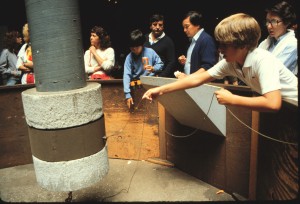I went to the Exploratorium this weekend, one of my favorite places in the bay area. It’s a humongous space featuring hundreds of exhibits demonstrating the world of science. There are earthquake sandboxes, motorized drum machines, human sized photo-reactive plates, tornado wind tunnels and arcing electrodes. As a rule, everything is interactive and designed to engage the widest possible audience. Everything has a lever or a scoop or a pulley to make it go. This means you’re the one making the exhibits work, and that means you are directly engaged in learning.

My favorite exhibit is the large concrete pendulum, found on the upper deck. It’s mounted in the ceiling of the space; it’s period is about ten seconds long. It’s also tethered to the floor immediately beneath the end, with a huge thick rope. This means the pendulum never swings more than a few feet in any direction. This rope also provides some friction, slowing it’s motion when no one is playing with it. There’s a barrier around the swinging area to stop people from touching the pendulum directly. So, how do you get it to move?
Around the edge of the barrier are little magnets tethered to the wall. If you swing the magnet out, you can attach it to the metal side of pendulum. Here comes the clever part: If you pull on the string just a little bit, you can add a tiny amount of energy to the pendulum. If you pull too hard, or when the pendulum is moving away from you, your magnet pops off the side and you have to swing it out again. There is an immediate and necessary type of learning going on here. If you want to play, you have to play with the rules the pendulum sets for you. You have to respect harmonic motion!
Like many of the exhibits, the pendulum supports multiple people playing and interacting with each other. This is great, because people can pull from both sides and get the thing really swinging. It also helps demonstrate what has to be done to people who are just walking up. There’s a sign explaining the science behind it, but I think it’s entirely unnecessary. A minute of playing with this gives you a genuine personal connection.

